Consumer goods major Marico, which crossed Rs 10,000 crore in topline in FY25, is looking to double turnover in five years, MD & CEO Saugata Gupta tells Viveat Susan Pinto in an exclusive interview. He throws light on the strategy he has put in place to achieve this, his agenda on digital acquisitions and outlook for the year. Edited excerpts:
You have set your sights on doubling turnover to Rs 20,000 crore by FY30. What building blocks are you putting in place to achieve this? And which segments will drive this growth?
We expect broad-based growth across India and overseas businesses on the back of steady growth in our core franchises and accelerated scale up of new businesses.
We’ve had a significant diversification over the last few years. In India, foods along with premium personal care, which includes our digital-first brands, contribute to 22% of the India business today.
This, we believe, could cross 25% in the next two to three years. We believe foods has significant potential for growth given the changing lifestyles of consumers and increased health awareness. We are targeting a revenue CAGR (compounded annual growth rate) of over 25% in foods, which will translate to eight times (8x) its FY20 size by FY27. This will be driven by segments such as oats, honey, soya, millets, snacking and muesli.
We expect overall volume growth in the core business to gradually improve with the newer segments of the portfolio continuing to grow over 20-25%.
Premiumisation of the core business (hair oils/edible oils) itself is a big opportunity for us. For instance, we are prototyping some of the premium hair oils, which have been successful in West Asia, in India. We have recently launched cold-pressed edible oils in quick commerce. We are evaluating the response to it. We are also prototyping baby care here after its success in Bangladesh. While there are new areas of growth from a diversification perspective, there is also a case for premiumising our core business.
Last but not least, we expect to sustain the double-digit constant currency growth momentum in the international business, which will also be aided by the expansion of the addressable market in our current geographies. These levers should help us double our current turnover in five years.
Most firms admit that competitive intensity in FMCG has grown post-Covid 19, with digital brands hurting players at the top end and small brands at the lower end. Are large, listed players doing enough to counter this challenge?
FMCG growth is not about listed firms alone. It is not a summation of the growth of just listed players. There are unlisted players, including D2C brands, unlisted MNCs and regional or local brands, whose performance may not be getting accurately captured by a retail audit. Commentary by unlisted players suggests a better performance underscored by broader demand resilience. Having said that, post-Covid-19, listed players have brought about significant changes in every function. From nano manufacturing to mass personalisation of products to the use of AI and data analytics in market research to embracing smart selling and distribution. There are sweeping changes that listed players have brought about in their operations to adjust to the new normal.
Will you continue to look at acquisitions in the direct-to-consumer (D2C) and digital space. You have four brands already in your digital-first portfolio at the moment?
We believe there is still space for doing a couple of more digital brand acquisitions in the next few years. This will be in adjacencies where we believe we have a right to win. As far as our current portfolio of digital-first brands is concerned, there is further scope for growth. Beardo (male grooming) and Plix (plant-based nutrition), for instance, have broken even and are likely to touch Rs 1,000 crore in combined ARR (average recurring revenue) this year (FY26). We see their pace of growth accelerating as we go forward. True Elements (digital-first food brand) and Just Herbs (Ayurvedic/Organic skin care) will take an 18-24-month period to break even. We are targeting an annual growth of about 20-25% in these two brands over the next few years.
While the government and the central bank have taken steps to mitigate stress in urban areas with fiscal and monetary policy measures, when do you see consumer confidence growing in urban centres?
Urban consumers were stressed in part due to rising inflation. With food inflation having cooled down and commodity inflation benign at the moment, the extra money that the fiscal and monetary policy measures will give consumers will help. While not all of it will go towards FMCG spending, it will improve sentiment and overall volume growth in the sector.
But many executives believe that the ongoing Iran-Israel conflict may hurt sentiment. While a ceasefire has been declared, the region remains volatile, which would impact crude and its derivatives. Does that worry you?
The current crisis in West Asia may not have a significant impact on domestic consumption. While input costs related to crude may increase, there could be a minor impact, nothing major. The risk management framework of most companies today have built in these scenarios. It is not a cause for worry at the moment.
What is your outlook for the FMCG market this year?
Volume growth this year (FY26) will be better than last year (FY25) given that rural demand is recovering and urban demand may show signs of revival following the fiscal and monetary policy stimulus. While revenue growth will show signs of improvement, profitability will depend on how external factors, including geopolitical issues pan out and its impact on commodities.
